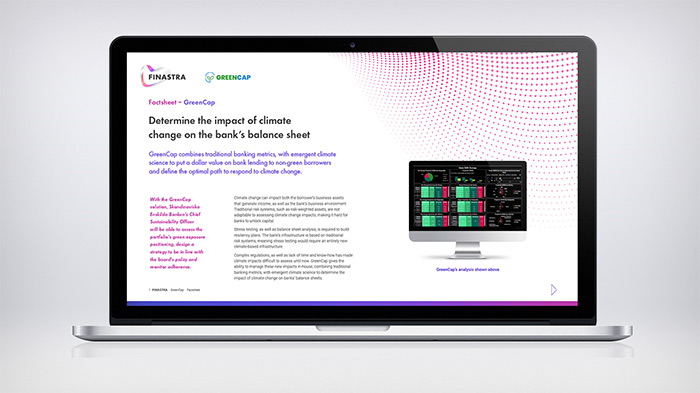
GreenCap
GreenPoint Global
GreenCap combines traditional banking metrics (RWA) with emergent climate science and international mitigation policies. It provides the means to put a dollar value on bank lending to non-green borrowers, in terms of funding the risk capital required to support that lending, combined with BIS compliant “green” stress testing and advisory service.
Banks’ current RWA systems and risk experts are not equipped to deal with the complex nature of climate risk calculations. It means that physical risk of extreme event is already miscalculated in their books. It also means that banks cannot accommodate transition risk: “brown” loans being already under-priced, while risk and price of “green” loans does not anticipate green incentives. Hence, banks cannot utilize their capital effectively and also cannot plan their green risk strategy as they can’t run green stress tests.
Unlock capital
Unlock capital by breaking down loan book by its “greenness”: assess which parts of the balance sheet are most susceptible to climate related credit impacts and most likely to attract adverse RWA based capital increases over the sort and mid-term.
Green stress testing
Stress testing are non-conventional: business as usual, or minor adaptations are not enough for compliance. Handle the entirely new infrastructure induced by Stress testing climate-based modeling by using multiple climate related economic scenarios. BIS compliant strategies ensure the bank can remain profitable by either including the future funding costs in brown loans or targeting its funding towards the green economy.
Turnkey low risk deployment
Integrates with LoanIQ. Merges an out of the box solution with a deep expert advisory service.
General information
How it works
GreenCap allows financial institutions to perform environmental impact assessments, set green balance sheet strategies, track new portfolio impact, and report to internal and external stakeholders through FFDC integration. It is primarily focused on LoanIQ, although it can be integrated with any other loan systems.
Transition and Physical Effects
Uses the standard Basel model for RWA as the foundation and extends the model to include transition and physical effects.Economic Impacts
Applies IPCC/NGFS estimates for economic impacts for these effects, also correlates borrowers, industries, and sectors to assess the economic impact.RWA calculation
Calculates business specific and institutional RWA both with and without the climate factors. The difference is the expected RWA increase (credit deterioration) due to climate change.RWA Impacts
Applies a green stress-test scenario and measures the RWA impacts alongside other banks performance metrics.A Standalone Solution
The integration makes use of the existing capability to pull LoanIQ into the FusionRisk database, and then the FusionRisk FFDC container. This way, GreenCap is implemented as a standalone solution.
How it looks
Unlock Capital and Test Loan Book Resiliently
GreenCap clearly shows which parts of the balance sheet are most susceptible to climate-related credit impacts and therefore, are most likely to attract adverse RWA-based capital increases over the short and midterm. Show lessNavigate through the Myriad Climate Scenarios
To ensure the bank's profitability, it offers the ability to run multiple climate-related economic scenarios and create strategies. Show lessCommunicate the Resiliency Strategy to the New Loan Level
Analyze the impact of new loans or facilities on the bank’s green strategy, with new loans or asset switches being testable against the sustainability goals. Show less



Unlock Capital and Test Loan Book Resiliently
GreenCap clearly shows which parts of the balance sheet are most susceptible to climate-related credit impacts and therefore, are most likely to attract adverse RWA-based capital increases over the short and midterm. Resources
